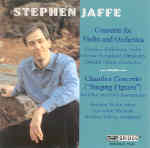Just recently I hailed the arrival of Lee Hyla’s fascinating Violin Concerto as a major contribution to the genre, and now here’s another sensational piece that deserves the widest possible dissemination among music lovers. At nearly 35 minutes, this is a major work by any standard, and Stephen Jaffe manages to fill up the time in a way that is completely satisfying both technically and formally, offering music that beguiles the ear, touches the heart, and satisfies the mind. This is not an achievement to be underestimated. Violin concertos in particular are extremely difficult to write, especially these days when composers are expected to use large orchestras with maximum coloristic variety, and this poses all kinds of problems regarding matters of balance and the relationship between the solo and the larger ensemble. To say that Jaffe has met his burden in this respect is an understatement.
The concerto that this one resembles most is that of Sibelius, though not in its harmonic or melodic style. There is one passage near the end of the finale where the soloist has some ascending and descending scales that sound rather like an affectionate tribute to the similar writing in the finale of the Sibelius, and we also hear some of those typically chugging Sibelian rhythmic ostinatos in strings and winds in the later stages of the first movement. But these are superficial resemblances. On a deeper level, Jaffe, like Sibelius, has found a way to place the solo front and center most of the time without the orchestra ever sounding inhibited or subdued. Sibelius does this by keeping his orchestral colors generally dark and somber so that the violin stands out in high relief. Jaffe’s method relies more on contrasting melodic and gestural shapes, allowing the orchestra bold interjections and colorful commentary against the soloist’s often more lyrical material.
It’s particularly gratifying in this respect to note that Jaffe accepts the violin’s basic nature as a melody instrument and writes tunes–very beautiful tunes and lots of them–and integrates these into a wide-ranging harmonic system that includes plenty of dissonance and the occasional “modern” sound effect or two. The final result comes awfully close to any reasonable music lover’s idea of what a modern violin concerto should be, offering a bow to tradition here and there, an easy entry into the composer’s musical world, but also plenty of character and originality with a style that never condescends or compromises its basic integrity. It deserves to become a classic.
Now pity us critics. In the fields of both early music and contemporary music there are so many really talented musicians performing at such a high level of technical accomplishment that there’s often nothing for us to do but say “Here it is! Come and get it!” This becomes even more depressing when you realize how few people will do just that, but hope must spring eternal or we wouldn’t keep trying. Self-pity aside, if you heard violinist Gregory Fulkerson’s Bach Sonatas and Partitas on Bridge (yes, this label records “normal” music too) then you know that he’s a fantastic player, and he sounds completely at ease in this technically demanding work. The Odense Symphony also plays with great confidence under Donald Palma, and the sound that Bridge has been getting from this source has been just about as good as it gets. Certainly the combination of warmth and clarity, with excellent balances between solo and orchestra, suits the music perfectly.
Jaffe’s Chamber Concerto is a tougher nut, though it’s 14 minutes shorter. Your reaction to it will to some extent depend on your tolerance for the tone of the solo oboe, however well played (and it’s very well played indeed by Stephen Taylor). Happily, Jaffe rarely asks the instrument to do anything sonically painful, though some of the writing is indeed quirky. In terms of instrumental color, he’s as inventive as ever. The small ensemble consists of a string trio and two keyboard players who share three instruments (piano, harpsichord, and celesta), and no matter how spasmodic the music gets in the two allegros there’s always a new aural attraction on the horizon, along with a really impressive variety of timbral contrast. The ends of both outer movements have a certain puckish wit, almost like a modern-day Poulenc, while the central slow movement offers a lovely lyrical contrast. As with the Violin Concerto, Speculum Musicae’s performances inspire nothing but admiration for both composer and performers, and with excellent sonics too–oh, what the hell…Here it is! Come and get it! [3/3/2004]
































